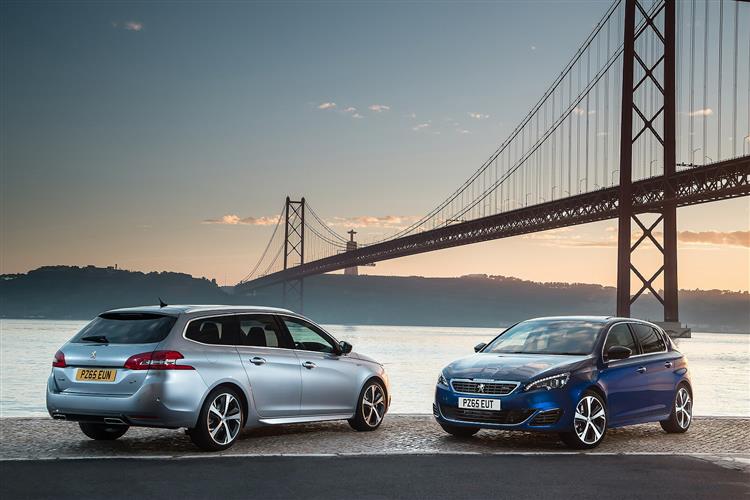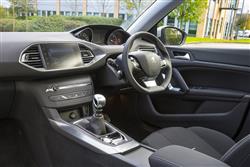PIECES OF EIGHT (some text hidden) --NONE--
By Jonathan Crouch
Introductionword count: 91
The Peugeot 308 evolved significantly in the second generation form launched in 2013. At first glance, the Focus-sized family hatchback formula might seem much the same as that of the first generation version, but the execution was miles better in this MK2 model, with a focus on refinement, interior quality and efficiency that put this car right up alongside the Ford and Volkswagen class leaders from its era. It's that good. There's a level of self-confidence and, yes, desirability here that we've not seen from Peugeot in a very long time.
Modelsword count: 46
5dr hatch / 5dr SW estate (Petrol - 1.2 THP 82bhp, 1.2 THP 110bhp, 1.6 THP 125bhp, 1.6 THP 156bhp, 1.6 THP 205bhp, 1.6 THP 250bhp, 1.6 THP 250 & 270bhp / Diesel - 1.6 HDi 90bhp, 1.6 HDi 115bhp, 1.6 BlueHDi 120bhp, 2.0 BlueHDi 150bhp)
Historyword count: 405
What do you look for in a used Astra-sized family hatchback? If it's driving excitement, you'll find it in a Ford Focus. If it's sheer value, then you're more likely to be drawn towards cars like Hyundai's i30 or Kia's cee'd. But what if your priorities are a bit more relaxed? You want an expensive feel. An absorbent ride. A laid back demeanour. And a car that makes you feel you're in something much nicer. Perhaps, just perhaps, you want one of these, Peugeot's second generation 308. Mid-sized compact Peugeots with a '3' designation go all the way back to the 301 of 1932, progressing through the pre-war 302 and the post-war 304 to the 305 and 306 models of the Eighties and Nineties. By then, the French brand had become less aspirational in the family hatchback segment as volume sales were chased with the forgettable 307 of 2001, the underpinnings of which also formed the basis for its less popular successor, the first generation 308 of 2007. By 2013 though, the market was changing, primarily with the continuing emergence of cheap Chinese and Korean rivals. Brands like Peugeot were feeling the need to move up-market, a small but significant premium shift that this model aimed to showcase to potential buyers who wanted a compact car from one of the smarter makers but couldn't quite stretch to one. Shouldn't it be called the '309'? Perhaps - but then, Peugeot sold a family hatchback of that name back in the late Eighties that was anything but up-market and moving a digit further on would have removed the distinctive 'middle O' prefix that the company seems to like so much. On top of that, '8' is a lucky number in China, which is this car's most important overseas market. So, 308 it is, which means that for the first time in this Gallic brand's history, an existing model name was carried over into an all-new design. And this MK2 308 was all-new in every sense thanks to its hi-tech EMP2 ('Efficient Modular Platform 2') underpinnings that support a smart, classy body powered by some engines that are pretty cutting edge. The result ought to be a car that used market family hatch buyers must take very seriously indeed if they're looking for a contender from his era. This 308 design was significantly upgraded in the Summer of 2017, but it's the earlier version we focus on here.
What You Getword count: 1290
Once upon a time, '30'-series Peugeots were a visual cut above the mainstream, with automotive historians fondly remembering the sweeping 301 and 302 models of the Thirties or even the Pininfarina-designed 305 that sustained the brand into the Eighties. Since then, it's hard to think of any compact family Peugeot that's made much of a driveway statement - until this one perhaps. It's slightly wider, slightly shorter and slightly lower than its predecessor, with shorter overhangs that push the wheels nearer to the four corners of an all-new modular EMP2 platform so sophisticated that it required no fewer than 116 patents. The handsome front end features a sculpted bonnet with distinctive swage lines that flow into sharky headlights offering LED lamps on plusher versions. The overall effect is a look that's confident, yet modern and restrained - which is exactly what you need if you're trying to push your company upmarket a bit. In the lower area of the front bumper, a wide air intake is framed by foglamps that incorporate directional indicators and are set into a C-shaped chromed surround. Moving back past the pebble-shaped door mirrors with their neat built-in LED turn lights, two strong character lines flow into a toned triangular rear three quarter panel that sits above subtly bulging rear haunches. The slim rear screen looks smart too, as do the small but intricately formed rear light clusters that when lit, illuminate a distinctive 'three-lion-claw' visual signature. Overall, there's a pleasingly understated maturity about the styling on offer here. It's not trying too hard. We like that. Sizewise, Peugeot clearly believes that less is more. In fact, we can't recall the last time we heard a manufacturer crow about the fact that its latest car was the smallest in its class - yet that's exactly what's on offer here. At only 4.25m long, this 308 is fully 12cm shorter than a Focus from this era - and it's shorter than an equivalent Golf too. Yet a larger 2.62 metre wheelbase and those restricted front and rear overhangs combine to ensure that cabin space standards remain class-competitive, pretty much the same as was the case with the MK1 model 308 in fact. You'll prove the point if you pull back one of the wide-opening doors and take a seat in the back. Here, as usual in this class, there's reasonable space for two adults but three will be cramped and kneeroom all-round could be better. Specify your car with the full-length cielo glass roof I have here and there's the bonus of an airy-feeling atmosphere but the downside is the way the arrangement robs taller passengers of those last few millimetres of headroom. On the plus side though, plusher variants like this one get a centre armrest-mounted ski-hatch that also lets rear seat passengers reach back for items they may have left in the boot. Moving from people space to package room, let's consider the boot, accessible via a low loading sill and a wider opening and 22% bigger than before. How can the smallest car in its segment offer the largest trunk? Answers on a postcard please. In total, there's 470-litres on offer back here, provided you include the useful 35-litre underfloor section with its useful divided storage compartments in that calculation. Overall, we're talking here of a space 25% bigger than that of a Volkswagen Golf, 35% larger than that of a Vauxhall Astra and a whopping 50% roomier than that of a Ford Focus. If you really need to maximise that trip to IKEA, you can use the optional ski hatch or fold the 60/40-split seats down completely and realise the full 1309-litre maximum loading capacity. No, the seats don't fold fully flat - the backrests simply flop onto the seat bases - but given the amount of space that's delivered, it seems churlish to grumble. If you do need more, then you'll need to talk to your dealer about the 308SW estate model. Take a place in one of the very comfortable seats up front in what Peugeot rather pretentiously calls the 'i-Cockpit' and four things are immediately apparent: quality, lack of button clutter, the big centre-dash LCD infotainment screen and, most notably, the tiny steering wheel above which (rather than through which) you're supposed to view the instruments with their finely sculpted red needles. Let's start with that, part of an arrangement first seen on the smaller 208 supermini but more effectively delivered here because it's easier to see the high-mounted dial pack above the wheel rim. Yes, it's a bit of a culture shock. Yes, you'll eventually get to like it. Yes, you should ignore whinging journalists who don't. With that issue out of the way, you can start to look around the cabin and try and appreciate what Peugeot has tried to do with the interior of this 308. With the possible exception of the rather incongruous-looking over-sized gear knob, it's all very nice indeed, with lovely touches like the Aston Martin-style contra-rotating rev counter. Plenty of soft-touch plastics and cool chrome finishes mean that the quality's certainly a cut above what you'd expect from a model priced against rivals from Ford, Vauxhall, Toyota and Renault. But perhaps we shouldn't be surprised by that. After all, Peugeot owns the company - Faurecia - that produces many of the premium quality interior furnishings you get in posh German cars. Jump into this model after familiarisation with an Astra or a Focus and you'll wonder where all the buttons have gone. There's a small central cluster of them in front of the gearstick for locking, heated rear window and hazard lights - and that's about it. Otherwise, everything's been relocated to the 9.7-inch colour LCD touchscreen that's standard on all but baseline models and dominates the centre of the dash. Whether you think that this is a good thing will depend of your point of view. The functions aren't as immediately intuitive as the usual knobs and dials of course and personally, I'd have separated the ventilation controls back out onto the dash. It's a bit annoying after all, to have to switch screens and jab away at a touchscreen every time you want to tweak the fan or alter the cabin temperature. Having said that, the set-up works well once you're used to it, featuring sat nav as standard, along with access to vehicle settings, Bluetooth 'phone functions, a stereo system which can include a 6.9GB Jukebox as well as a photo viewer and various optional driving aids, plus a selection of downloadable Peugeot Connect Apps. To activate and select from these, you'll need to pay an annual subscription which gets you a so-called 'Plug&Play 3G' key that slots into the USB port you'll find the glovebox. You'll then be able to get yourself apps telling you everything from the nearest parking space to traffic information, weather and tourist tips. The Coyote app's worth downloading too, a crowd-sourced warning system that briefs you on highway hold-ups, danger points and speed traps already encountered by over 2 million other road users. That only leaves cabin practicalities: the decently-sized 12-litre air conditioned glovebox. Door bins that can take a large 1.5-litre water bottle. A centre console with a sliding cover revealing a cupholder which can be swivelled out of the way so you can stash away wallets and 'phones. Plus there's a useful shelf directly under the central touchscreen that's ideal for iPods and MP3 players. Finally, I should mention the fact that you have to have an electric parking brake, not normally a feature I'm in favour of. This one though, is automatic and disengages without requiring a push - which is a big plus in its favour. What To Look For
To see the full road test text contact us on 0330 0020 227
Pictures (high res disabled)

.jpg)
|

|
Scoring (subset of scores)
Category: Compact Family Cars
| Performance | |
| Handling | |
| Comfort | |
| Space | |
| Styling, Build, Value, Equipment, Depreciation, Handling, Insurance and Total scores are available with our full data feed. | |



